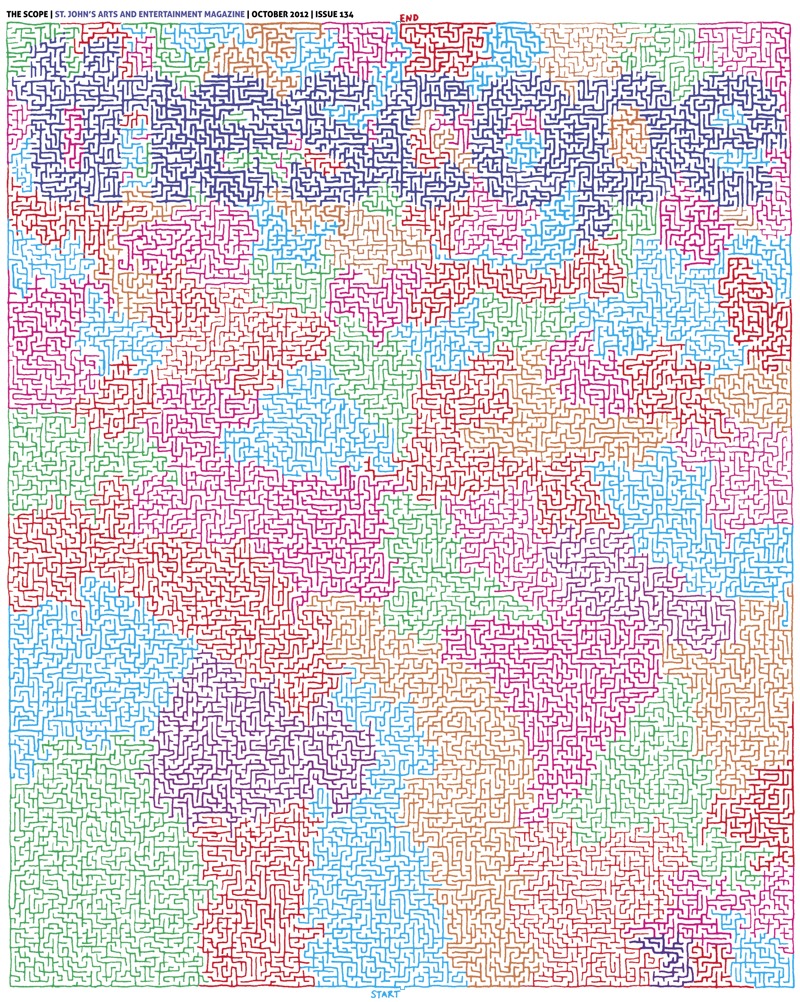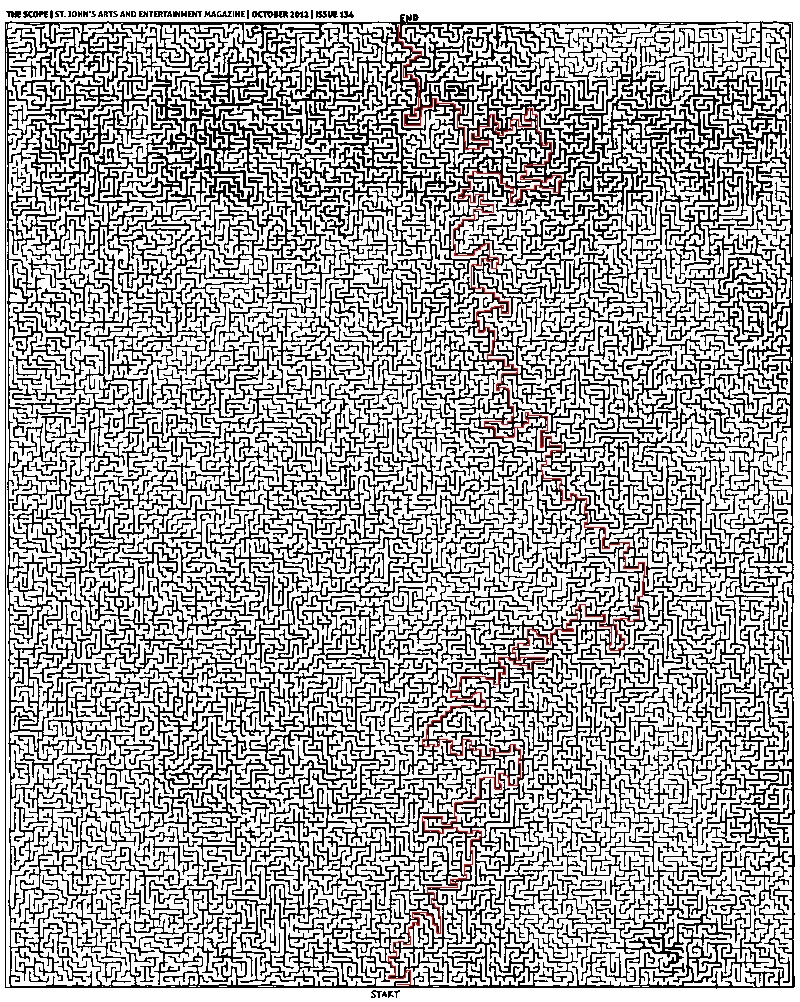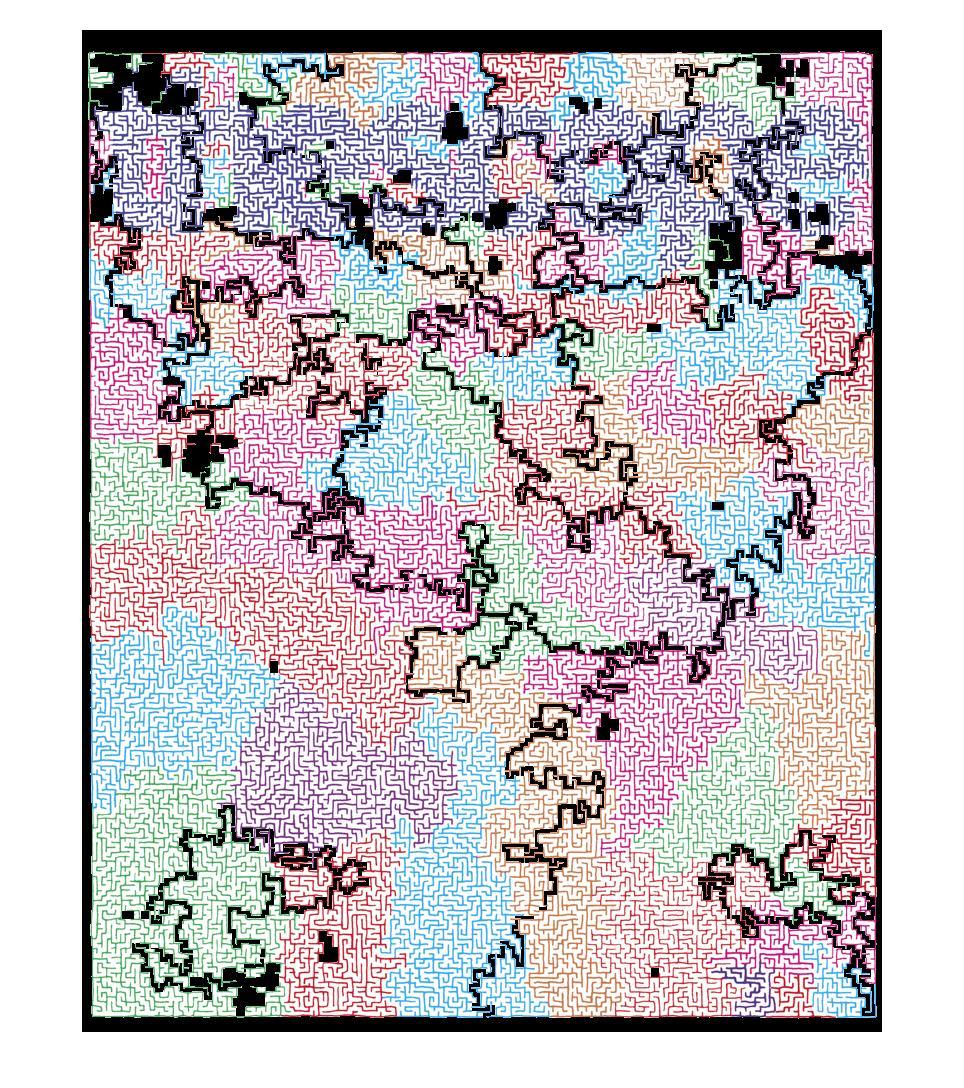
英文原文:Representing and solving a maze given an image
译注:原文是 StackOverflow 上一个如何用程序读取迷宫图片并求解的问题,几位参与者热烈地讨论并给出了自己的代码,涉及到用 Python 对图片的处理以及广度优先(BFS)算法等。
问题 by Whymarrh:

当给定上面那样一张 JPEG 图片,如何才能更好地将这张图转换为合适的数据结构并且解出这个迷宫?
我的第一直觉是将这张图按像素逐个读入,并存储在一个包含布尔类型元素的列表或数组中,其中 True 代表白色像素,False 代表非白色像素(或彩色可以被处理成二值图像)。但是这种做法存在一个问题,那就是给定的图片往往并不能完美的“像素化”。考虑到如果因为图片转换的原因,某个非预期的白色像素出现在迷宫的墙上,那么就可能会创造出一一条非预期的路径。
经过思考之后,我想出了另一种方法:首先将图片转换为一个可缩放适量图形(SVG)文件,这个文件由一个画布上的矢量线条列表组成,矢量线条按照列表的顺序读取,读取出的仍是布尔值:其中 True 表示墙,而 False 表示可通过的区域。但是这种方法如果无法保证图像能够做到百分之百的精确转换,尤其是如果不能将墙完全准确的连接,那么这个迷宫就可能出现裂缝。
图像转换为 SVG 的另一个问题是,线条并不是完美的直线。因为 SVG 的线条是三次贝塞尔曲线,而使用整数索引的布尔值列表增加了曲线转换的难度,迷宫线条上的所有点在曲线上都必须经过计算,但不一定能够完美对应列表中的索引值。
假设以上方法的确可以实现(虽然很可能都不行),但当给定一张很大的图像时,它们还是不能胜任。那么是否存在一种更好地方法能够平衡效率和复杂度?
这就要讨论到如何解迷宫了。如果我使用以上两种方法中的任意一种,我最终将会得到一个矩阵。而根据这个问答(http://stackoverflow.com/questions/3097556/programming-theory-solve-a-maze/3097677#3097677),一个比较好的迷宫表示方式应该是使用树的结构,并且使用A*搜索算法来解迷宫。那么如何从迷宫图片中构造出迷宫树呢?有比较好的方法么?
以上废话太多,总结起来问题就是:如何转换迷宫图片?转换成为什么样的数据结构?采用什么样的数据结构能够帮助或阻碍解迷宫?
回答 by Mikhail:
这是我的解决方案:
1. 将图片转换为灰度图像(不是直接二值),调整不同颜色的权重使得最终的灰度看起来比较统一,你可以通过简单地调节 Photoshop 图像->调整->黑白菜单中的控制条来实现。
2. 将上一步得到的灰度图片转换为二值图片,可以通过在 PS 图像->调整->阈值菜单中设定适当的阈值来实现
3. 确保正确设置了阈值。使用魔棒工具(参数设置:容差 0、取样点、连续以及消除锯齿)选择空白区域,检查所选区域的边缘不是因为错误的阈值设置而产生的假边缘。事实上,这个迷宫中从 start 到 end 应该由联通的空白区域。
4. 人为地在迷宫外部加上边界,确保迷宫漫游者^_^不会从 start 绕着迷宫跑到终点。:)
5. 选择语言实现广度优先搜索算法(BFS),从 start 处开始让程序运行。下面的代码我选择用 Matlab 实现。正如 Thomas 提到的,没必要纠结于图像的表示形式,你可以直接在二值图像上运行。
以下是用 MATLAB 实现的 BFS 代码:
function path = solve_maze(img_file)
%% Init data
img = imread(img_file);
img = rgb2gray(img);
maze = img > 0;
start = [985 398];
finish = [26 399];
%% Init BFS
n = numel(maze);
Q = zeros(n, 2);
M = zeros([size(maze) 2]);
front = 0;
back = 1;
function push(p, d)
q = p + d;
if maze(q(1), q(2)) && M(q(1), q(2), 1) == 0
front = front + 1;
Q(front, :) = q;
M(q(1), q(2), :) = reshape(p, [1 1 2]);
end
end
push(start, [0 0]);
d = [0 1; 0 -1; 1 0; -1 0];
%% Run BFS
while back <= front
p = Q(back, :);
back = back + 1;
for i = 1:4
push(p, d(i, :));
end
end
%% Extracting path
path = finish;
while true
q = path(end, :);
p = reshape(M(q(1), q(2), :), 1, 2);
path(end + 1, :) = p;
if isequal(p, start)
break;
end
end
end这是个简单的实现,应该很容易就能够改写为 Python 或其他语言,下面是程序的运行结果:

提问者更新:
我用 Python 实现了一下 Mikhail 的方法,其中用到了 numpy 库,感谢 Thomas 推荐。我感觉这个算法是正确的,但是效果不太如预期,以下是相关代码,使用了 PyPNG 库处理图片。
译注:很遗憾,我用提问者提供的代码并没有跑通程序,并且似乎代码缩进有点问题,而下面其他参与者的代码能够执行通过,并且效果很好。
import png, numpy, Queue, operator, itertools
def is_white(coord, image):
""" Returns whether (x, y) is approx. a white pixel."""
a = True
for i in xrange(3):
if not a: break
a = image[coord[1]][coord[0] * 3 + i] > 240
return a
def bfs(s, e, i, visited):
""" Perform a breadth-first search. """
frontier = Queue.Queue()
while s != e:
for d in [(-1, 0), (0, -1), (1, 0), (0, 1)]:
np = tuple(map(operator.add, s, d))
if is_white(np, i) and np not in visited:
frontier.put(np)
visited.append(s)
s = frontier.get()
return visited
def main():
r = png.Reader(filename = "thescope-134.png")
rows, cols, pixels, meta = r.asDirect()
assert meta['planes'] == 3 # ensure the file is RGB
image2d = numpy.vstack(itertools.imap(numpy.uint8, pixels))
start, end = (402, 985), (398, 27)
print bfs(start, end, image2d, [])回答 by Joseph Kern:
#!/usr/bin/env python
import sys
from Queue import Queue
from PIL import Image
start = (400,984)
end = (398,25)
def iswhite(value):
if value == (255,255,255):
return True
def getadjacent(n):
x,y = n
return [(x-1,y),(x,y-1),(x+1,y),(x,y+1)]
def BFS(start, end, pixels):
queue = Queue()
queue.put([start]) # Wrapping the start tuple in a list
while not queue.empty():
path = queue.get()
pixel = path[-1]
if pixel == end:
return path
for adjacent in getadjacent(pixel):
x,y = adjacent
if iswhite(pixels[x,y]):
pixels[x,y] = (127,127,127) # see note
new_path = list(path)
new_path.append(adjacent)
queue.put(new_path)
print "Queue has been exhausted. No answer was found."
if __name__ == '__main__':
# invoke: python mazesolver.py [.jpg|.png|etc.]
base_img = Image.open(sys.argv[1])
base_pixels = base_img.load()
path = BFS(start, end, base_pixels)
path_img = Image.open(sys.argv[1])
path_pixels = path_img.load()
for position in path:
x,y = position
path_pixels[x,y] = (255,0,0) # red
path_img.save(sys.argv[2])动态执行效果:

回答 by Jim
使用树搜索太繁杂了,迷宫本身就跟解路径是可分的。正因如此,你可以使用连通区域查找算法来标记迷宫中的连通区域,这将迭代搜索两次这些像素点。如果你想要更好地解决方法,你可以对结构单元使用二元运算(binary operations)来填充每个连通区域中的死路。
下面是相关的 MATLAB 代码及运行结果:
% read in and invert the image
im = 255 - imread('maze.jpg');
% sharpen it to address small fuzzy channels
% threshold to binary 15%
% run connected components
result = bwlabel(im2bw(imfilter(im,fspecial('unsharp')),0.15));
% purge small components (e.g. letters)
for i = 1:max(reshape(result,1,1002*800))
[count,~] = size(find(result==i));
if count < 500
result(result==i) = 0;
end
end
% close dead-end channels
closed = zeros(1002,800);
for i = 1:max(reshape(result,1,1002*800))
k = zeros(1002,800);
k(result==i) = 1; k = imclose(k,strel('square',8));
closed(k==1) = i;
end
% do output
out = 255 - im;
for x = 1:1002
for y = 1:800
if closed(x,y) == 0
out(x,y,:) = 0;
end
end
end
imshow(out);
回答 by Stefano
stefano 童鞋给出了生成搜索过程 GIF 及 AVI 文件的代码 maze-solver-python (GitHub)

以上就是如何用程序解图片迷宫的内容,更多相关内容请关注PHP中文网(m.sbmmt.com)!




